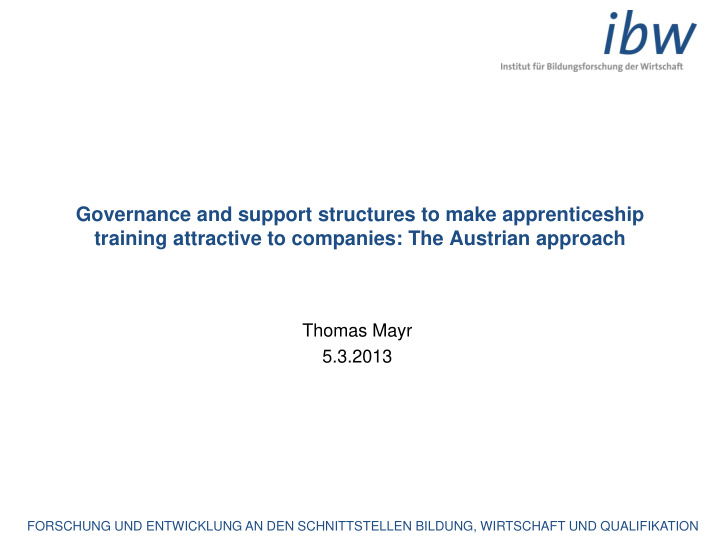



Governance and support structures to make apprenticeship training attractive to companies: The Austrian approach Thomas Mayr 5.3.2013 FORSCHUNG UND ENTWICKLUNG AN DEN SCHNITTSTELLEN BILDUNG, WIRTSCHAFT UND QUALIFIKATION
Background I: Austria’s Social Partnership Chambers as corporations under public law with compulsory membership Federal and regional Economic Chambers – WKÖ (employers) Federal and regional Chambers of Labour – AK (employees) Chambers of Agriculture and Forestry (employers in agriculture) Associations Federation of Austrian Industry – IV Trade Union Confederation – ÖGB Main roles Consultative roles in policy making: legislation and administration Collective agreements Shared responsibility for entities such as: Social insurance institutions, Public Employment Service Service to their members The role of Social Partners in VET policy making and delivery is embedded in a general structure and tradition of corporatism
Background II: Main initial VET programmes Dual Apprenticeship training • training enterprise (80% of time) and part-time vocational school (20% of time) • demand led system: apprenticeship contract between enterprise and apprentice • training is based on two regulations (ordinances): training company and school • 200 + apprenticeships (“professions”) in practically all branches of the economy with a 2-4 years training period depending on the profession • Access to regulated professions and basis for “Higher VET”: “Meister” and other professional qualifications awarded by Economic Chambers Full time VET Schools and Colleges • combination of general and vocational education • different types and duration (1-5 years) Double qualification in VET-colleges (5 years): VET-diploma and university access • 3
Some statistics: education and economic indicators Austria: 76,8% Proportion of students in VET at Sec II EU-average: 52,8% Austria: 86% Completion rate of Sec II EU-average: 78,6% Austria: 8,7% Early school leavers EU-average: 14,4% Austria: 23,5% Tertiary attainment EU-average: 32,3% Austria: 8,3% Youth unemployment EU-average: 21,4% Austria: 116,3 Labour productivity EU: 100 4 Sources: Eurostat, OECD; latest year available (2009-2011)
Why do companies train? Business case: return on investment Challenge: to move from informal arrangements to formal training with recognised qualifications Catalyst: institutions and governance structure, support to companies The Austrian approach: Content (profile of the different apprenticeship trades) is negotiated between Social Partners in the Federal Advisory Board Administration and competent authority: Economic Chambers act as intermediate bodies: accreditation as training company, organisation of the exam, award of qualification etc. and as contact points for companies Accompanying support measures: financial incentives, practical training guidelines, selection tools and services for recruitment, trainer academies and networks, services to organise international mobility etc. 5
The system perspective: Governance of apprenticeship training ENTERPRISE BASED TRAINING SCHOOL BASED EDUCATION AND TRAINING Ministry of Ministry of Economics Education Federal Level Federal Advisory Board (Social Partners) Apprenticeship Office Regional (Economic Chambers ) Education Board Provincial Level Regional Advisory Provincial Board Governor Training Vocational Local Level School Company 6 Source: ibw
Apprenticeship training and its institutions from the perspective of an SME Apprenticeship office at Research & Research & Economics Ministry Apprenticeship office at local Economic Chamber Development institute Development institute local Economic Chamber private and public institutes Research & Economic Chamber Development institute Economic Chamber Economics Ministry CVET Providers of and PES International Young Chambers Workers Exchange CVET Provider of Chambers Exam / After Exam / After Before the Before the Recruitment Recruitment Training Training the the apprenticeship apprenticeship apprenticeship apprenticeship Support tools Training guidelines Trainer academies Organisation of exam and Accreditation as training for recruitment and networks company awarding of qualification Organisation of Support/study material for National competitions, Online vacancy training alliances examiners and apprentices Trainer qualification Euro / World Skills platform Financial incentives Excellency Award „Fit for future “ Training for examiners Mobility: work placements abroad
Further information VET in Europe. Country report Austria . Edited by ibw in the framework of Cedefop-ReferNet http://www.ibw.at/images/ibw/bbs/bb_europa_12_en.pdf Apprenticeship training: Dual vocational Education and Training in Austria. BMWFJ 2013; edited by ibw (http://www.ibw.at/de/infomaterial/5-infomaterial/i023/P235-apprenticeship) Learning for jobs. OECD Reviews of Vocational Education and Training. Austria http://www.oecd.org/edu/45407970.pdf www.ausbilder.at: practical information and support tools for training companies and especially trainers (BMWFJ, WKÖ; edited by ibw) www.bic.at: online tool for career guidance (BMWFJ, WKÖ; edited by ibw) 8
ibw Institute for Research on Qualifications and Training of the Austrian Economy Rainergasse 38 1050 Wien www.ibw.at info@ibw.at 9
Recommend
More recommend